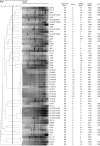Emergence of multidrug-resistant Campylobacter species isolates with a horizontally acquired rRNA methylase
- PMID: 24982085
- PMCID: PMC4135855
- DOI: 10.1128/AAC.03039-14
Emergence of multidrug-resistant Campylobacter species isolates with a horizontally acquired rRNA methylase
Abstract
Antibiotic-resistant Campylobacter constitutes a serious threat to public health, and resistance to macrolides is of particular concern, as this class of antibiotics is the drug of choice for clinical therapy of campylobacteriosis. Very recently, a horizontally transferrable macrolide resistance mediated by the rRNA methylase gene erm(B) was reported in a Campylobacter coli isolate, but little is known about the dissemination of erm(B) among Campylobacter isolates and the association of erm(B)-carrying isolates with clinical disease. To address this question and facilitate the control of antibiotic-resistant Campylobacter, we determined the distribution of erm(B) in 1,554 C. coli and Campylobacter jejuni isolates derived from food-producing animals and clinically confirmed human diarrheal cases. The results revealed that 58 of the examined isolates harbored erm(B) and exhibited high-level resistance to macrolides, and most were recent isolates, derived in 2011-2012. In addition, the erm(B)-positive isolates were all resistant to fluoroquinolones, another clinically important antibiotic used for treating campylobacteriosis. The erm(B) gene is found to be associated with chromosomal multidrug resistance genomic islands (MDRGIs) of Gram-positive origin or with plasmids of various sizes. All MDRGIs were transferrable to macrolide-susceptible C. jejuni by natural transformation under laboratory conditions. Molecular typing of the erm(B)-carrying isolates by pulsed-field gel electrophoresis (PFGE) and multilocus sequence typing (MLST) identified diverse genotypes and outbreak-associated diarrheal isolates. Molecular typing also suggested zoonotic transmission of erm(B)-positive Campylobacter. These findings reveal an emerging and alarming trend of dissemination of erm(B) and MDRGIs in Campylobacter and underscore the need for heightened efforts to control their further spread.
Copyright © 2014, American Society for Microbiology. All Rights Reserved.
Figures


References
-
- Blaser MJ, Engberg J. 2008. Clinical aspects of Campylobacter jejuni and Campylobacter coli infections, p 99–121 In Nachamkin I, Szymanski CM, Blaser MJ. (ed), Campylobacter, 3rd ed. ASM Press, Washington, DC
-
- Gupta A, Nelson JM, Barrett TJ, Tauxe RV, Rossiter SP, Friedman CR, Joyce KW, Smith KE, Jones TF, Hawkins MA, Shiferaw B, Beebe JL, Vugia DJ, Rabatsky-Ehr T, Benson JA, Root TP, Angulo FJ, NARMS Working Group 2004. Antimicrobial resistance among Campylobacter strains, United States, 1997–2001. Emerg. Infect. Dis. 10:1102–1109. 10.3201/eid1006.030635 - DOI - PMC - PubMed
Publication types
MeSH terms
Substances
LinkOut - more resources
Full Text Sources
Other Literature Sources
Medical
Molecular Biology Databases

